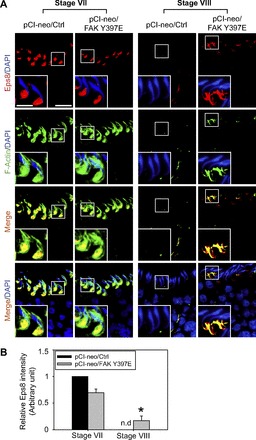Fig. 3.

FAK Y397E phosphomimetic mutant-induced defects in spermiation in the rat testis is mediated by disrupting stage-specific and spatiotemporal expression of epidermal growth factor receptor pathway substrate 8 (Eps8) and F-actin at the apical ES. A: in control testes (pCI-neo/Ctrl), Eps8 (red) was highly expressed at the apical ES in stage VII tubules, colocalizing with F-actin (green), to maintain the integrity of actin filament bundles at the apical ES. However, Eps8 was considerably diminished to a level almost nondetectable (nd) at stage VIII, along with diminishing F-actin to facilitate spermiation. While overexpression of pCI-neo/FAK Y397E did not impede the expression and distribution of Eps8 in stage VII tubules, its overexpression retained the expression of Eps8 and also F-actin in stage VIII tubules, as well as their colocalization. This thus impeded spermiation, retaining elongated spermatids in the epithelium as shown in Fig. 1, C and D. Cell nuclei visualized by DAPI. Scale bar = 60 and 15 μm in inset, which apply to corresponding micrographs and insets. B: image analysis of Eps8 (red) at the apical ES surrounding the head of step 19 spermatids (n = 300 spermatids from 4 rat testes) in which the level of Eps8 in pCI-neo/Ctrl in stage VII tubules was arbitrarily set at 1. pCi-neo/FAK Y397E was compared with the control group in either stage VII or VIII tubules. *P < 0.05.
